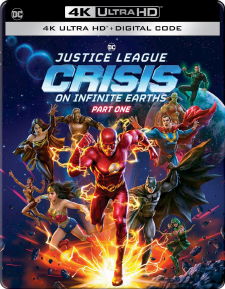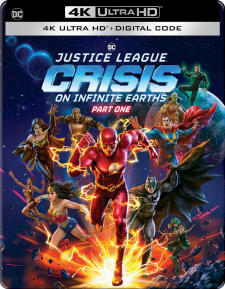Justice League: Crisis on Infinite Earths – Part One (Steelbook) (4K UHD Review)

Director
Jeff WamesterRelease Date(s)
2024 (January 23, 2024)Studio(s)
DC Studios/Warner Bros Animation (Warner Home Video)- Film/Program Grade: B-
- Video Grade: A-
- Audio Grade: B+
- Extras Grade: C
Review
“In the beginning there was only one, a single black infinitude, so cold and dark for so very long that even the burning light was imperceptible. But the light grew, and the infinitude shuddered, and the darkness finally screamed, as much in pain as in relief. For in that instant a multiverse was born. A multiverse of worlds, vibrating and replicating... and a multiverse that should have been one, became many.”
With those opening words, writer Marv Wolfman fired a shot heard ‘round the comic book world in the form of DC’s epic 1985-1986 crossover event Crisis on Infinite Earths. Along with artist George Pérez, Wolfman would end up redefining the entire DC comic universe, as well as the nature of comic book storytelling itself. Nothing at DC would be the same, and the ripples from this disturbance in its continuity would be felt throughout the rest of the comic book ecosphere, Marvel included. The concept of multiverses had been an inevitable offshoot of the growth of the comic book medium, since every time that a series or character was rebooted, it would introduce a new continuity that didn’t necessarily erase the old ones. Prior to 1985, all of those continuities usually existed separately, and that tended to form an insurmountable barrier for new readers. How could they possibly make sense of all of it? Wolfman shattered those barriers with Crisis on Infinite Earths by shattering the barriers that existed between the multiverses. He drew all of them, kicking and screaming, into one single master continuity where every one of them now existed as a part of the same whole. Those screams would be shared by fans, because in the process, he killed off many beloved characters in order to streamline everything. Nothing really was the same after Crisis on Infinite Earths.
At its core, Crisis on Infinite Earths is a dialectical clash between matter and anti-matter, in this case represented by the Monitor and his opposite number the Anti-Monitor. The Monitor serves as a cosmic watcher, viewing and cataloging all of the various multiverses that have existed since the beginning of time. When a being who will come to be known as Pariah discovers the existence of an anti-matter universe, his hubris causes a destructive accident that destroys his own reality, causes the expansion of the anti-matter universe, and unleashes the Anti-Monitor. The Anti-Monitor’s goal is to swallow up all of the existing multiverses, leaving only his own to fill in the gap. In response, the Monitor selects superheroes from each of the remaining multiverses to help him stem the tide of chaos, sending his own assistant Harbinger to gather all of them together. Yet the Anti-Monitor has plans of his own, and even Harbinger and the Monitor aren’t safe from his clutches. Needless to say, the fate of the multiverses hangs in the balance.
The devil is in the details, however. The challenge with adapting Crisis on Infinite Earths into another medium lies in the fact that while the basic structure can easily be replicated, the characters and storylines can’t. Wolfman’s Crisis on Infinite Earths was based on all of the DC characters and continuities that were already in place in 1985, and without that background, there’s no way to make sense of any of it. The solution that writer James Krieg and director Jeff Wamester came up with was not to even try. Their DC Animated Universe adaptation of Crisis on Infinite Earths isn’t really an adaptation of the comic books at all. Instead, it’s really the DCAU version of Wolfman’s basic concept, reworking it to utilize the characters, continuities, and storylines that have been established over the course of seven different previous DCAU installments that fans have affectionately dubbed the Tomorrowverse.
The Tomorrowverse saga launched in 2020 with the reboot Superman: Man of Tomorrow. That was followed by Justice Society: World War II, the two-part Batman: The Long Halloween, Green Lantern: Beware My Power, Legion of Super-Heroes, and Justice League: Warworld. All of these films take place in the same general continuity, and they established the building blocks that would be used in Justice League: Crisis on Infinite Earths. (The other DCAU films released during that same timeframe are standalone entries that aren’t a part of this continuity.) The Monitor and the Anti-Monitor are still the primary antagonists, with Harbinger serving a similar function, but everything else is tailored more to the Tomorrowverse than it is to what Wolfman and Pérez originally created.
Justice League: Crisis on Infinite Earths – Part One launches the new saga and lays the groundwork for the two parts that are to follow. While the comic books were fairly egalitarian in terms of the time that was allotted to all of the myriad superheroes, Part One of the DCAU saga is centered around the Barry Allen version of The Flash (voiced by Matt Bomer). Allen was a major character in the comic books (along with other versions of The Flash), but not quite to the same extent that he is here, and definitely not in the same fashion. In this version, The Flash has been “time tripping,” journeying through the various stages of his own life, and he also ends up visiting the different multiverses. Once the Monitor has assembled the superheroes that he hopes can assist him in saving the remaining multiverses, Barry Allen proves to be the key.
At its heart, Justice League: Crisis on Infinite Earths – Part One is really the love story between Barry Allen and Iris West (Ashleigh LaThrop), with the time tripping element serving as a way to show their relationship develop from its very beginning to the bittersweet conclusion. Considering how complex and diffuse the overall story arc of Crisis on Infinite Earths must be regardless of whether it’s the comic book version or this Tomorrowverse adaptation, that’s not a bad way of drawing in viewers and helping to establish the stakes. When Wolfman decided how various heroes would meet their fates, he had the advantage of decades of previous material that lent gravitas to the proceedings. The Tomorrowverse doesn’t really have the same level of background for all of its characters, so Part One needed to do double duty in order to establish the consequences of what’s going to happen to some of them. How that will play out in Part Two and Part Three remains to be seen, but for now, Part One provides a solid start for the saga.
Justice League: Crisis on Infinite Earths – Part One was rendered digitally at 1.78:1, and while there’s no information available regarding the resolutions involved, it was likely finished as a 2K Digital Intermediate. For this Ultra HD version, the 2K DI has been upscaled to 4K and graded for High Dynamic Range (only HDR10 is included on the disc). While DC Animation has been exploring different styles in some of their recent DCAU offerings, all of the Tomorrowverse installments have stayed with the same basic design, using deliberately flat 2D characters with broad Archer-style black outlines. The heavy linework doesn’t necessarily take advantage of 4K resolution, but everything still seems slightly crisper and clearer in 4K than it does in 1080p. The textures in the backgrounds do benefit a bit from the upgrade, but the biggest advantages still probably come down to the fact that the greater bandwidth means that there’s less compression. There’s not necessarily more depth to the colors, but the contrast does benefit from the HDR10 pass, with a bit more detail to the gradations between light and dark.
Primary audio is offered in English 5.1 DTS-HD Master Audio. It’s a pretty typical DCAU mix, with most of the sonic energy being focused on the front channels, and many of the sound effects being anchored to the center channel. Most of the stereo spread is provided by Kevin Riepl’s score, and the surrounds are generally limited to ambient effects. Other than the music, there’s not much directionality to be had here. It’s an adequate mix for this sort of material, but other DCAU titles like Legion of Super-Heroes have done better, so it’s still a bit disappointing given the gravitas of a storyline like Crisis on Infinite Earths.
Additional audio options include French and Spanish 5.1 Dolby Digital. Subtitle options include English SDH, French, Dutch, and Spanish.
The Warner Bros. 4K Ultra HD Steelbook release of Justice League: Crisis on Infinite Earths – Part One is UHD only—there’s no Blu-ray included in the package, but there is a Digital Code on a paper insert. The Blu-ray version is a separate release. That’s pretty typical for Warner Bros. these days, as they’ve stopped offering combo packs for most titles. Adjust your plans accordingly. The following extras are included:
- Crisis on Infinite Earths – Part One: Crisis Prime(r) (HD – 9:39)
- Crisis on Infinite Earths – Part One: The Selfless Speedster (HD – 8:02)
Crisis Prime(r) features interviews with Jim Krieg, Jeff Wamester, executive producer Butch Lukic, and former DC animation director Mike Carlin. They step through the seven previous films in the Tomorrowverse saga and show how each of them established some of the pieces that would be necessary to tell this version of Crisis on Infinite Earths. While that means it does offer a spoiler or two, anyone who hasn’t seen all of the previous films (or just doesn’t remember them very well) would be well-served by watching this before starting Part One. There’s not much depth here, but it still serves as a decent refresher. The Selfless Speedster also includes Krieg and Wamester, but adds voice actor Matt Bomer, DC president Jim Lee, original Crisis inker Jerry Ordway, original Crisis associate editor Robert Greenberger, and none other than Marv Wolfman. The DC comics vets explain why they used The Flash as a main character for Crisis on Infinite Earths, and how what happened to Barry Allen in the saga served as a way to pass the torch to the Wally West version of the character. Krieg and Wamester discuss the process of adapting that storyline, and why their version of Barry Allen’s saga is so different than it was in the books. Needless to say, this featurette leans more heavily into spoiler territory, so save it until after you watch Part One.
Given the fact that Justice League: Crisis on Infinite Earths – Part One breaks with the Marv Wolfman/George Pérez comic book run by virtue of necessity, it will be interesting to see the directions that Krieg and Wamester take for Part Two and Part Three. Will they find a way to tie things back more directly to the comics, or will they continue to strike their own course, using only the basic concept from the comics? The latter seems more likely than the former, but time will tell. Fortunately, both follow-ups are scheduled for 2024, so we won’t have to wait long to find out.
- Stephen Bjork
(You can follow Stephen on social media at these links: Twitter and Facebook.)

